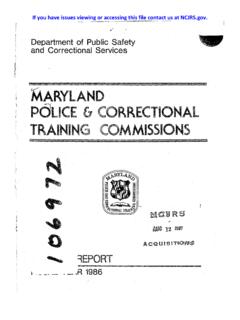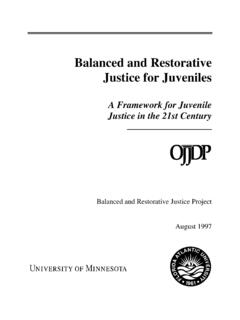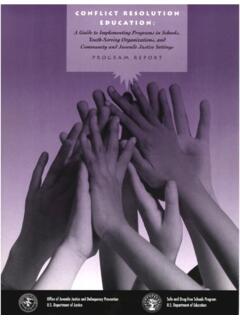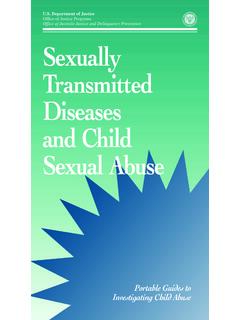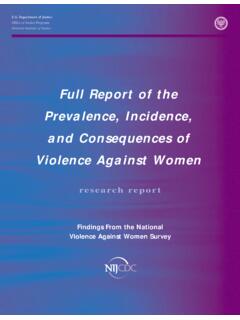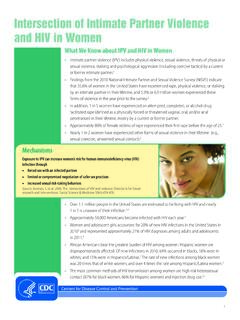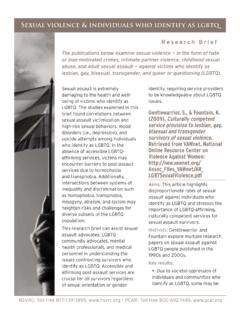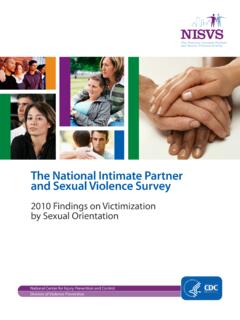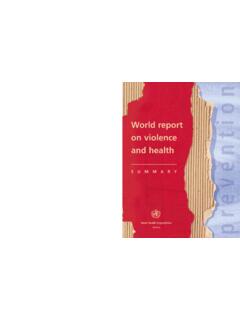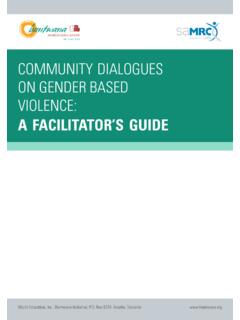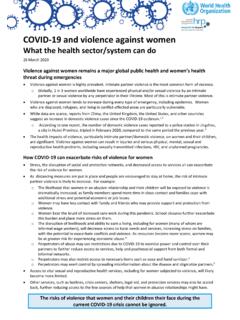Transcription of Intimate Partner Violence - National Criminal Justice ...
1 Intimate Partner ViolenceTrendsIn 2015, the rate of Intimate Partner violent victimization among women rose about 46% over the previous year. However, in the 20 years since 1995, the rates of violent Intimate Partner victimization among men and women have decreased by 98% and 65%, respectively. Because the personal nature of these victimizations often influences a victim s decision to report the crime, victimizations by Intimate partners are highly underreported. In 2015, violent victimizations committed by family members were reported more frequently than those committed by Intimate partners, followed by acquaintances (either well-known or casual) and Did You Know?10% of high schoolers who report being in a dating relationship experience physical Violence by a boyfriend or girlfriend; 10% also experience sexual of homicides are committed by Intimate 20% of women who identify as victims of Intimate Partner Violence report that they experience 1 or more PTSD symptoms, compared to 5% of National Crime Victims Rights Week Resource Guide: Crime and Victimization Fact SheetsIntimate Partner Violence (IPV), often called domestic Violence , is generally described as abuse within the context of an Intimate Partner relationship, where one Partner asserts power and control over the other.
2 While legal definitions vary by state, IPV can include physical, sexual, and psychological abuse, as well as economic coercion. IPV affects millions of individuals, regardless of marital status, sexual orientation, race, age, religion, education, or economic status. Because of the seriousness of this crime, the effects on victims and their families, and the difficulties in the Criminal Justice system response, victims of IPV may require sustained resources, including access to emergency shelter, housing assis-tance, protection orders, safety planning, support groups, financial assistance, and other forms of to the National Intimate Partner and Sexual Violence Survey (NISVS), an estimated 47% of men and women will be victims of psychological aggression by an Intimate Partner in their lifetime.
3 In addition, 1/3 of women will be victims of physical Violence , and 1/4 of contact sexual Violence ,* by an Intimate Partner . Almost 1/4 of men will be victims of physical Violence by an Intimate Partner Victimization by SexA rate per 1,000 * Contact sexual Violence includes rape, being made to penetrate a perpetrator, sexual coercion, and unwanted sexual Estimate of Intimate Partner ViolenceBby sex and type of victimization50% sexual Violence * aggressionOther familyIntimate partnerStrangerAcquaintancePercent of Victimizations Reported to PoliceAby victim s relationship to offender19950%10%20%30%40%50%60%70%80%46 433134674019971999200720092003201380% Bureau of Justice Statistics, National Crime Victimization Survey, Concate-nated File, 1992-2015, ( Department of Justice )B Matthew J.
4 Breiding et al., Prevalence and Characteristics of Sexual Vio-lence, Stalking, and Intimate Partner Violence Victimization, NISVS 2011, MMWR vol 63, 8(2014): CDC, Youth Behavior Surveillance System, 2015, FBI, Crime in the United States, 1995 - 2015, ( Department of Justice ), Table 10 E Emily Waters, Lesbian, Gay, Bisexual, Transgender, Queer, and hiv -Af-fected Intimate Partner Violence in 2015, ( National Coalition of Anti-Vi-olence Programs, 2016), aggression is the most common form of Intimate Partner Violence , affecting men and women of all races and ethnicities. The percentage of American Indian and Alaska Native women estimated to be victimized by Intimate partners is higher than any other race or ethnicity.
5 ( National estimates of IPV are not reported for men across all ethnicities.)B Households earning between $15,000 and $24,999 reported slightly more Intimate Partner victimizations in 2015 than other households. However, Intimate Partner Violence is not isolated to any particular income 2015, the National Coalition of Anti- Violence Programs collected information from almost 2,000 LGBTQ and hiv -affected individuals who had been victims of Intimate Partner Violence . Of these, 43% identified as gay, 19% as lesbian, 10% as bisexual, and 9% as queer; and 41% were under 30 years old, while 30% were age 30 Data on Intimate Partner ViolenceIn more than 80% of Intimate Partner violent victimizations, the victim did not receive assistance from victim service agencies in estimated 71% of female Intimate Partner victims are victimized before age 25; 23% before age 18.
6 Comparatively, 58% of male Intimate Partner victims are victimized before age 25; 14% before age of Intimate Partner Violence against WomenB by race/ethnicityAmerican Indian/Alaska , Non-HispanicBlack, sexual violencePhysical violencePsychological aggression0%20%40%60%80%100%HispanicBlac k, Non-HispanicWhite, Non-HispanicAmericanIndian/AlaskaNativeM ultiracialContact Sexual ViolencePhysical ViolencePsychological AggressionPercentage of Intimate Partner ViolenceE by victim s sexual orientationGay (43%)Lesbian (19%)Heterosexual (16%)Bisexual (10%)Queer (9%)Other (3%)Percentage of Intimate Partner Violence (By Sexual Orientation)GayLesbianBisexualHeterosexu alQueerOtherIntimate Partner Victimizations for which Victim Received ServicesA from victim service agenciesDid not receive services (82%)Received services (18%)IPV Victims Who Recieved Service from Victim Service Agencies ReceivedDid Not ReceiveAge of First Intimate Partner VictimizationB by sexBefore 18 Before $75,000 or more$50,000 $74,999$35,000 $49,999$25,000 $34,999$15,000 $24,999$7,500 $14,999 Less than $7,500150,000 Intimate Partner Violence by Household IncomeA in thousands of victimizations


